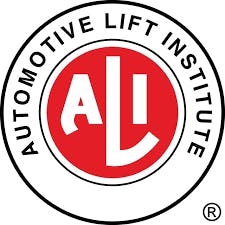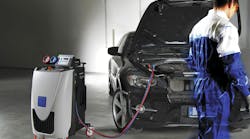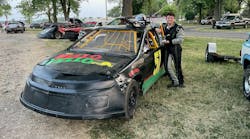- … at least one of the four restraint arms on the hoist had swung out of place, causing the entire vehicle to slip off the restraint arms and fall. Examination of the arm restraints revealed that the gears that were supposed to lock the arms in place were not functioning properly. The teeth on the gears were worn, rusted and in poor condition and the metal bars that hold the restraints together were bent.
- Ministry of Labour inspectors tested the equipment and found several shortcomings. One of the swing arms moved easily out of the set position when pushed by hand; a second swing arm moved out of position when forcibly pushed by hand and a third swing arm moved out of the set position when forcibly pushed by two inspectors. A Ministry of Labour engineer concluded that the restraint devices had not functioned properly for an extended period of time.
- Pads on the swing arms were found to be worn and in poor condition.
- Several of the other hoists in the workplace were examined and found to be in similarly poor condition. A privately retained hoist inspector concluded that the hoists showed years of wear and identified a number of items that needed to be addressed in each hoist. Four of the hoists failed their examinations.
- A company had previously been hired by Lakeshore Motors to inspect all hoists at the workplace. That company performed the inspections, which were primarily visual and lasted approximately 15 minutes per hoist. The company indicated that there were no defects in the hoists and that they were fit to use.
- Neither the company nor its owner were certified by the Automotive Lift Institute as lift inspectors. (This certification is not required by the Occupational Health and Safety Act or its regulations.)
- The equipment manual for the hoist involved in the incident states that all moving parts and telescopic arms should be inspected daily for evidence of uneven or excessive wear. Furthermore, arm restraints are to be inspected and lubricated every two months. Investigation by the Ministry of Labour revealed no such inspections had taken place on any of the hoists and that such inspections, if done properly, would have uncovered the defects.
- Lakeshore Motors had not provided the workers with any information or instruction on inspection requirements and had not trained or instructed the workers on how to inspect the hoists. As a result, there was no regular maintenance routine in place for the hoists.
- The hoist that failed on February 21, 2017 had not been inspected prior to use. Furthermore, the joint health and safety committee had not performed any monthly inspections of the workplace in January or February 2017.
ALI reminds dealers, shop owners and other employers to take their role in lift safety seriously. ANSI/ALOIM, the national standard covering Safety Requirements for Automotive Lift Operation, Inspection and Maintenance, requires:
- All vehicle lifts must be inspected by a qualified lift inspector at least annually. (ALI developed North America’s only program to independently test and certify qualified lift inspectors. Inspectors who successfully complete the program become ALI Certified Lift Inspectors.)
- Every lift operator must be instructed in the safe use and operation of the lift using the manufacturer-provided instructions and warning labels and the Automotive Lift Institute publications Quick Reference Guide, Vehicle Lifting Points for Frame Engaging Lifts, Lifting It Right, Safety Tips and the ALOIM standard itself. This training should be documented.
- The owner or employer shall establish a periodic planned maintenance procedure in accordance with the lift manufacturer’s recommendations in order to ensure reliability and allow the continued safe operation of the lift.
Technicians also must take responsibility for their own safety when using lifts, including:
- Operating the lift only after being properly trained.
- Using all applicable safety features provided on the lift and operating the lift in accordance with manufacturer instructions.
- Maintaining the cleanliness and orderliness of the lift and its surroundings.
-
Inspecting/taking notice of the following features on a daily basis:
- Accessibility and readability of the operating procedures, safety tips and general safety material
- Accessibility and readability of safety warning labels
- Readability of the rated load capacity of the lift
- Proper operation of the lift controls
- Deformation or excessive wear of any of the lift structural components
- Deformation or excessive wear of other components such as hoses, electrical wires, drive chains, wire rope or screws
- Damage or excessive wear on any of the lift contact points which engage the vehicle during lifting, whether they engage the tires, frame, body or axles
- Evidence of hydraulic or pneumatic leaks
- Unusual noises, sudden movements, erratic operation or evidence of chips or filings during use
- Cracks or loose concrete around floor anchor bolts, if employed
- If any of the conditions described above are observed before, during or after the operation of the lift, the operator should stop using the lift and report the condition to the supervisor, employer or owner. Additionally, the lift should not be used until the cause of the problem has been determined and the appropriate repairs have been made by qualified automotive service personnel.
“This case is a sad example of the real-world consequences of not properly maintaining and inspecting vehicle lifts and not training lift operators,” says R.W. “Bob” O’Gorman, ALI president. “We encourage every lift owner to take this message to heart. At least once a year, have all of your lifts inspected and train all of your technicians. And technicians, check your lift every day. If something isn’t right, don’t take a risk—report it immediately to your supervisor. After all, your safety is riding on it.”
ALI’s Lifting It Right lift safety training course, safety manual and other lift safety training materials, as well as a directory of ALI Certified Lift Inspectors, are available on autolift.org.


